Internationalization Process of SMEs: Strategies and Techniques. A Case Study of Wales, UK SMEs.
Added on 2023-06-13
22 Pages5932 Words175 Views
Internationalization Process of SMEs 1
Internationalization Process of SMEs: Strategies and Techniques. A Case Study of Wales,
UK SMEs.
by
Course:
Tutor:
University:
Department:
Date:
Internationalization Process of SMEs: Strategies and Techniques. A Case Study of Wales,
UK SMEs.
by
Course:
Tutor:
University:
Department:
Date:
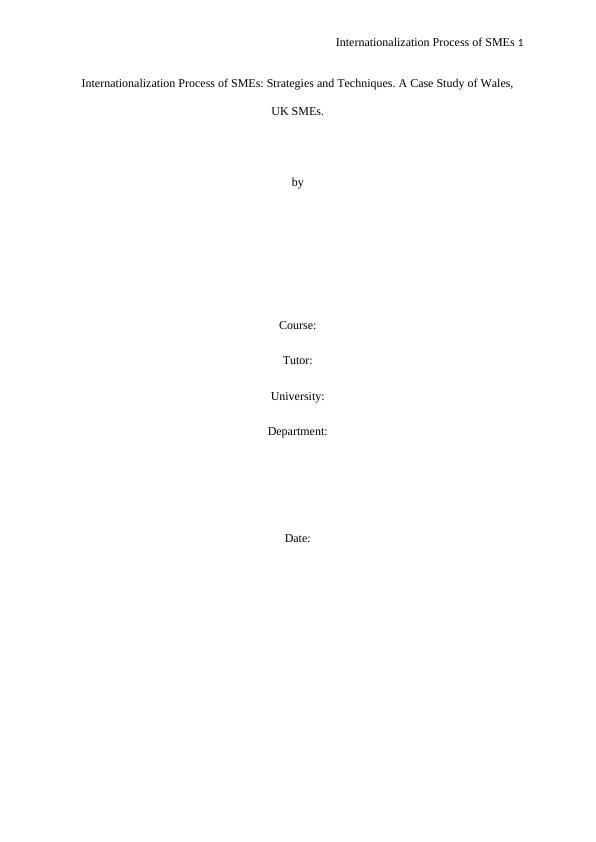
Internationalization Process of SMEs 2
Table of Contents
Table of Contents.....................................................................................................................2
ABSTRACT..............................................................................................................................2
CHAPTER ONE: INTRODUCTION....................................................................................4
1.1 Background Information..........................................................................................................4
1.2 Research Question.....................................................................................................................5
CHAPTER TWO: LITERATURE ASSESSMENT.............................................................6
2.1 Introduction...............................................................................................................................6
2.2 Theoretical Background............................................................................................................6
2.2.1 Internationalization Theory...............................................................................................6
2.2.2 The Uppsala Internationalization Process Model (U-model)...........................................7
2.2.3 Network Theory..................................................................................................................8
2.3 Internationalization Process and the SME’s............................................................................9
2.4 Entry Modes for International Markets................................................................................10
2.4.1 Exporting...........................................................................................................................11
2.4.2 Turnkey Projects..............................................................................................................11
2.4.3 Licensing............................................................................................................................12
2.4.4 Franchising........................................................................................................................12
2.4.5 Joint Ventures...................................................................................................................13
CHAPTER THREE: PROPOSED RESEARCH METHODOLOGY..............................13
3.1 Introduction.............................................................................................................................13
3.2 Research design........................................................................................................................13
3.3 Study Population......................................................................................................................14
3.4 Data Collection.........................................................................................................................14
3.5 Proposed Data Analysis...........................................................................................................15
3.6 Ethical Issues............................................................................................................................15
3.7 Study Limitations....................................................................................................................15
3.8 Proposed Work Plan................................................................................................................15
References...............................................................................................................................17
ABSTRACT
The current advancements in technology, elimination of trade barriers among others have
influenced the need for rapid globalization allowing effective internationalization of the
Table of Contents
Table of Contents.....................................................................................................................2
ABSTRACT..............................................................................................................................2
CHAPTER ONE: INTRODUCTION....................................................................................4
1.1 Background Information..........................................................................................................4
1.2 Research Question.....................................................................................................................5
CHAPTER TWO: LITERATURE ASSESSMENT.............................................................6
2.1 Introduction...............................................................................................................................6
2.2 Theoretical Background............................................................................................................6
2.2.1 Internationalization Theory...............................................................................................6
2.2.2 The Uppsala Internationalization Process Model (U-model)...........................................7
2.2.3 Network Theory..................................................................................................................8
2.3 Internationalization Process and the SME’s............................................................................9
2.4 Entry Modes for International Markets................................................................................10
2.4.1 Exporting...........................................................................................................................11
2.4.2 Turnkey Projects..............................................................................................................11
2.4.3 Licensing............................................................................................................................12
2.4.4 Franchising........................................................................................................................12
2.4.5 Joint Ventures...................................................................................................................13
CHAPTER THREE: PROPOSED RESEARCH METHODOLOGY..............................13
3.1 Introduction.............................................................................................................................13
3.2 Research design........................................................................................................................13
3.3 Study Population......................................................................................................................14
3.4 Data Collection.........................................................................................................................14
3.5 Proposed Data Analysis...........................................................................................................15
3.6 Ethical Issues............................................................................................................................15
3.7 Study Limitations....................................................................................................................15
3.8 Proposed Work Plan................................................................................................................15
References...............................................................................................................................17
ABSTRACT
The current advancements in technology, elimination of trade barriers among others have
influenced the need for rapid globalization allowing effective internationalization of the
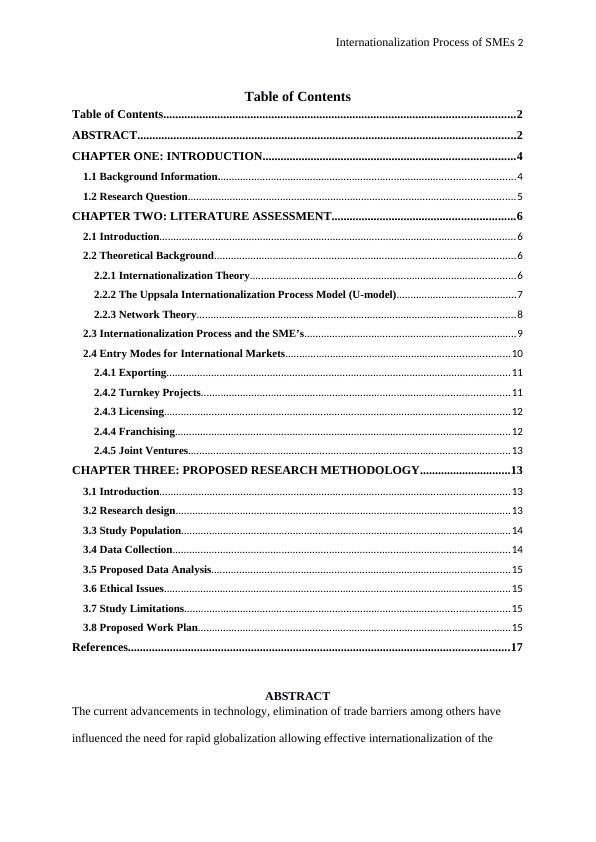
Internationalization Process of SMEs 3
SMEs. The objective of this research study is to provide an in-depth understanding of the
process of internationalization of SMEs with a specific focus on the strategies and entry
techniques. The research question is; what is the internationalization process for SME’s, and
the strategies and techniques for its success? This study proposes both qualitative and
quantitative research methods, with closed interviews used in data collection. The research
instrument will be structured and unstructured questionnaires, and the data analysis is to be
done using SPSS.
SMEs. The objective of this research study is to provide an in-depth understanding of the
process of internationalization of SMEs with a specific focus on the strategies and entry
techniques. The research question is; what is the internationalization process for SME’s, and
the strategies and techniques for its success? This study proposes both qualitative and
quantitative research methods, with closed interviews used in data collection. The research
instrument will be structured and unstructured questionnaires, and the data analysis is to be
done using SPSS.
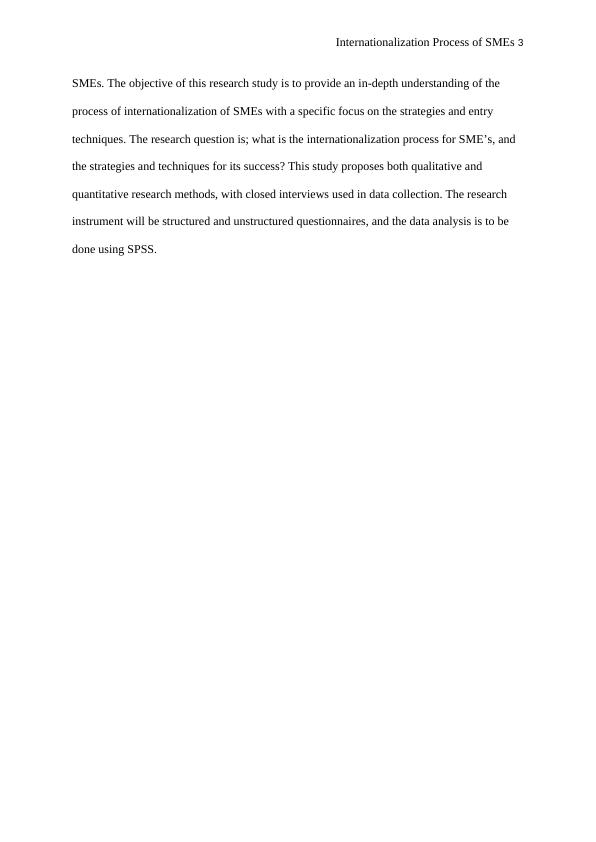
Internationalization Process of SMEs 4
CHAPTER ONE: INTRODUCTION
1.1 Background Information.
Globalization of international economies through trade and investment among other factors
have been the trend in the dynamic business market in the recent years (Cavusgil, and Knight,
2015). The success of businesses in foreign countries necessitates the use of different
strategies and techniques by the leadership (Maurin and Yeophantong, 2013). Much attention
has been given to internationalization process regarding the active role of small and medium
enterprises (SMEs) in the international markets. The most explored theories and models in
the field of internationalization include The Uppsala Internationalization Process Model,
Network Theory, and International Entrepreneurship Theory among others (Schulz, Borghoff,
and Kraus, 2009). The stage model was used some decades back, and it comprises of a
process where corporations begin from local markets and gradually rise to the international
market and at last owns subsidiaries in foreign nations. This is the nature of the Uppsala
model by Vahlne and Johanson (2017). The Network Approach was later introduced by
Johanson and Mattsson (2015), in which the authors emphasized the significance of
relationships with suppliers, clients, and market that can assist a company to go global.
The advancement of technology, reduced trade barriers, etc. are supporting the integration of
the global economy and as a result, this fast globalization enabling SMEs to go worldwide at
a speedy and effective rate (Dunning, 2014). This has prompted in-depth research and
criticism of the existing theories on internationalization processes and strategies. The
internationalization process is beset with risks and uncertainties which substantially affect the
organization’s strategy. Strategy formulation is a significant process which precedes
internationalization process, and it’s about deciding on the type of market, time and the entry
mode (Vahlne and Johanson, 2017). Successful internationalization requires businesses to
minimize risks and uncertainties, and this can be achieved through the choice of the right
CHAPTER ONE: INTRODUCTION
1.1 Background Information.
Globalization of international economies through trade and investment among other factors
have been the trend in the dynamic business market in the recent years (Cavusgil, and Knight,
2015). The success of businesses in foreign countries necessitates the use of different
strategies and techniques by the leadership (Maurin and Yeophantong, 2013). Much attention
has been given to internationalization process regarding the active role of small and medium
enterprises (SMEs) in the international markets. The most explored theories and models in
the field of internationalization include The Uppsala Internationalization Process Model,
Network Theory, and International Entrepreneurship Theory among others (Schulz, Borghoff,
and Kraus, 2009). The stage model was used some decades back, and it comprises of a
process where corporations begin from local markets and gradually rise to the international
market and at last owns subsidiaries in foreign nations. This is the nature of the Uppsala
model by Vahlne and Johanson (2017). The Network Approach was later introduced by
Johanson and Mattsson (2015), in which the authors emphasized the significance of
relationships with suppliers, clients, and market that can assist a company to go global.
The advancement of technology, reduced trade barriers, etc. are supporting the integration of
the global economy and as a result, this fast globalization enabling SMEs to go worldwide at
a speedy and effective rate (Dunning, 2014). This has prompted in-depth research and
criticism of the existing theories on internationalization processes and strategies. The
internationalization process is beset with risks and uncertainties which substantially affect the
organization’s strategy. Strategy formulation is a significant process which precedes
internationalization process, and it’s about deciding on the type of market, time and the entry
mode (Vahlne and Johanson, 2017). Successful internationalization requires businesses to
minimize risks and uncertainties, and this can be achieved through the choice of the right
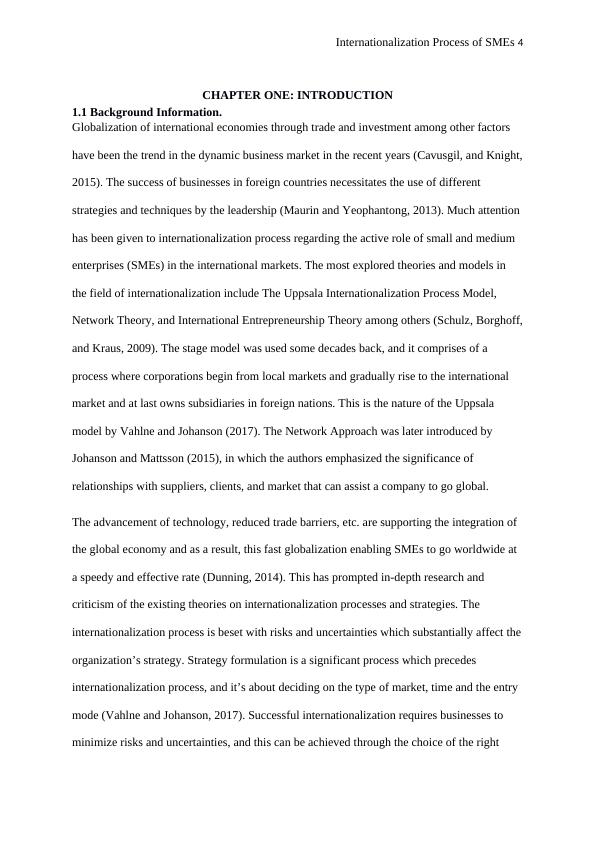
Internationalization Process of SMEs 5
method and strategy. Internationalization requires proper planning which involves the
decision on the speed and timing of the process in addition to the mode of entry to adopt. To
this end, this study seeks to address the process of internationalization with regard to
strategies and techniques.
1.2 Research Question
What is the internationalization process for SME’s, and the strategies and techniques for its
success?
method and strategy. Internationalization requires proper planning which involves the
decision on the speed and timing of the process in addition to the mode of entry to adopt. To
this end, this study seeks to address the process of internationalization with regard to
strategies and techniques.
1.2 Research Question
What is the internationalization process for SME’s, and the strategies and techniques for its
success?
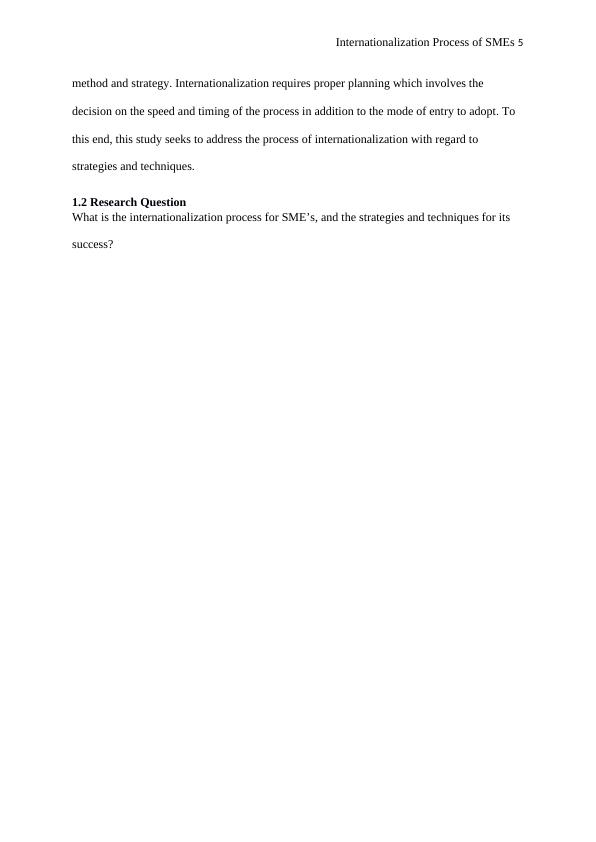
Internationalization Process of SMEs 6
CHAPTER TWO: LITERATURE ASSESSMENT
2.1 Introduction
This chapter outlines the literature on the internationalization of business activities by SMEs.
The section also includes a review of literature undertaken by other researchers, relevant to
the topic under study. These include the theoretical background, Internationalization Process
and the SME’s, entry Modes for International Markets, empirical Literature, and
2.2 Theoretical Background
2.2.1 Internationalization Theory
Internationalization theory proposes that it is more profitable for production companies to
exist singly in given locations. The first approach to exploring the benefits of
internationalization in firms is to highlight the significance of technology transfer (Pedersen
and Shaver, 2011). Brennan and Garvey (2009) posit that there is complexity on the buyer
when appraising the real value of knowledge. Additionally, it is not possible to quantify
knowledge in monetary terms and sell it, and also it is challenging to secure intellectual
property rights. As a result, it is more profitable for businesses to start a new enterprise in the
international market than to sell technology to another enterprise (Lee et al., 2012).
The focus of the second method is on vertical integration which implies an apparent dispute
between firms. Furthermore, coordination issues may arise due to the imbalances in demand
and supply between two enterprises. Unstable prices pose substantial risks for both
organizations (Pedersen and Shaver, 2011). Hence, this model posits that the critical issue in
internationalization is lack of knowledge concerning markets which are associated with the
costs, clients and the alternatives regarded by the decision makers.
Experiential knowledge reduces the risks encountered in expanding to the foreign market and
also acts as a mechanism for attaining internal and external knowledge and of the chance of
combining both (Brennan and Garvey, 2009). On the other hand, Sandberg (2013) notes that
CHAPTER TWO: LITERATURE ASSESSMENT
2.1 Introduction
This chapter outlines the literature on the internationalization of business activities by SMEs.
The section also includes a review of literature undertaken by other researchers, relevant to
the topic under study. These include the theoretical background, Internationalization Process
and the SME’s, entry Modes for International Markets, empirical Literature, and
2.2 Theoretical Background
2.2.1 Internationalization Theory
Internationalization theory proposes that it is more profitable for production companies to
exist singly in given locations. The first approach to exploring the benefits of
internationalization in firms is to highlight the significance of technology transfer (Pedersen
and Shaver, 2011). Brennan and Garvey (2009) posit that there is complexity on the buyer
when appraising the real value of knowledge. Additionally, it is not possible to quantify
knowledge in monetary terms and sell it, and also it is challenging to secure intellectual
property rights. As a result, it is more profitable for businesses to start a new enterprise in the
international market than to sell technology to another enterprise (Lee et al., 2012).
The focus of the second method is on vertical integration which implies an apparent dispute
between firms. Furthermore, coordination issues may arise due to the imbalances in demand
and supply between two enterprises. Unstable prices pose substantial risks for both
organizations (Pedersen and Shaver, 2011). Hence, this model posits that the critical issue in
internationalization is lack of knowledge concerning markets which are associated with the
costs, clients and the alternatives regarded by the decision makers.
Experiential knowledge reduces the risks encountered in expanding to the foreign market and
also acts as a mechanism for attaining internal and external knowledge and of the chance of
combining both (Brennan and Garvey, 2009). On the other hand, Sandberg (2013) notes that

End of preview
Want to access all the pages? Upload your documents or become a member.
Related Documents
(PDF) The Uppsala model on evolution of the multinationallg...
|26
|11642
|100
The Role of Business Intelligence in the Internationalisation process of SMEslg...
|4
|629
|79
Literature Review on MNE Entry and Impacts on Host Countrylg...
|11
|1103
|327
BUS804 - International Business Strategylg...
|14
|3010
|97
MBA Solved Assignments Samplelg...
|34
|7412
|132
International Business Strategy PDFlg...
|11
|4090
|218
